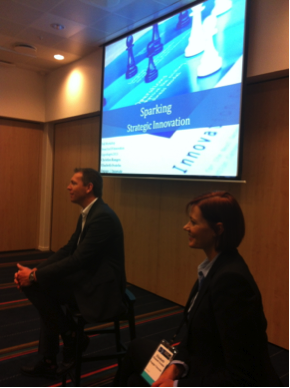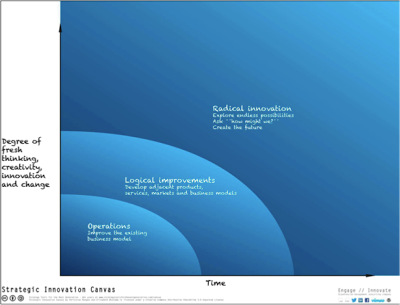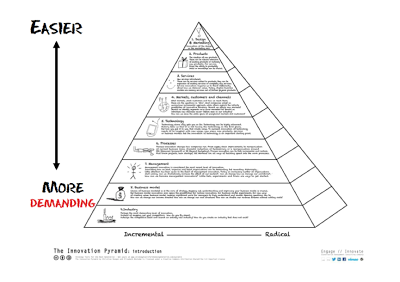Behavior Analysis
Live from FEI EMEA 2013: Workshop Sparking Strategic Innovation

Christian Rangen and
Elisabeth Ovstebo, ENGAGE // INNOVATE, Authors of 'Dream Bigger:
Your Personal Innovation Sketchbook' (2012) and 'Strategy Tools for the
Next Generation' (2013), about Strategy,
Innovation and Management Tools for the Next Generation of Entrepreneurs,
Risk-Takers and Pirates.
Elisabeth Ovstebo, ENGAGE // INNOVATE, Authors of 'Dream Bigger:
Your Personal Innovation Sketchbook' (2012) and 'Strategy Tools for the
Next Generation' (2013), about Strategy,
Innovation and Management Tools for the Next Generation of Entrepreneurs,
Risk-Takers and Pirates.
The slides of this
workshop are all available and downloadable here: http://www.slideshare.net/engage-innovate. The session was mainly driven and facilitated by Christian
who introduced three tools for reflecting in a structured manner about a
company's innovation agenda:
- the 'spidermap'; a holistic view on innovation
- the Strategic Innovation Canvas
- the Innovation Pyramid
Before kicking off, we engaged in some simple exercises that
familiarized us with the differences between the engineering approach, and more
guessing approach. Not that one is better than the other: it just makes you
aware that people in your company have different styles of thinking.
familiarized us with the differences between the engineering approach, and more
guessing approach. Not that one is better than the other: it just makes you
aware that people in your company have different styles of thinking.
The goal of the first workshop was to create new thinking
modes for innovation. Most strategic exercises could be modeled on a chessboard:
the rules of the game are 'within' the chessboard, and usually existing mental
models are applied when creating strategy. The workshop learned that there is a
spectrum from existing 'strategy as analysis' models to 'strategy as
innovation'
modes for innovation. Most strategic exercises could be modeled on a chessboard:
the rules of the game are 'within' the chessboard, and usually existing mental
models are applied when creating strategy. The workshop learned that there is a
spectrum from existing 'strategy as analysis' models to 'strategy as
innovation'
The 'spidermap' proved to be a good tool for setting the
innovation agenda, and provides a static view of why we innovate, what we
innovate and how we innovate. But it
remains a static view. It would be nice to see this model evolve to something
that can document the evolution over time of a company's innovations efforts,
and to be able to mark what changes when for example the CEO changes directions
of the company.
innovation agenda, and provides a static view of why we innovate, what we
innovate and how we innovate. But it
remains a static view. It would be nice to see this model evolve to something
that can document the evolution over time of a company's innovations efforts,
and to be able to mark what changes when for example the CEO changes directions
of the company.
Next, dived into strategy tools for next generation. There
was a great overview slide of the 'history of business strategy'
was a great overview slide of the 'history of business strategy'
It is striking to see how in many organizations, these are
the tools that are still used for defining strategy, most probably because most
of our leaders have been trained this way when they were doing their MBAs.
the tools that are still used for defining strategy, most probably because most
of our leaders have been trained this way when they were doing their MBAs.
The key message was that we are moving from a traditional linear
thinking towards an increasing level of non-linear thinking, scenario planning
and disruptive business strategies.
thinking towards an increasing level of non-linear thinking, scenario planning
and disruptive business strategies.
There was a real energizing part when the presenters
introduced different levels of thinking modes; check out www.strategytoolsforthenextgeneration.com
for details. The story was in essence about levels of innovation: core,
adjacencies, new territories and disruption, but wrapped in a modern language
using terminology such as 'dream bigger', 'pirate thinking', 'corporate attach helicopter', etc
introduced different levels of thinking modes; check out www.strategytoolsforthenextgeneration.com
for details. The story was in essence about levels of innovation: core,
adjacencies, new territories and disruption, but wrapped in a modern language
using terminology such as 'dream bigger', 'pirate thinking', 'corporate attach helicopter', etc
'We need brave people, innovative CEOs need bravery, and
innovation only happens when there is a brave innovative CEO' were some of the
more sloganesque statements during this session.
innovation only happens when there is a brave innovative CEO' were some of the
more sloganesque statements during this session.
The message was really about how language creates reality.
In a subsequent exercise, the participants were invited to
experiment with the 'Innovation Canvas', a fairly simple ' not simplistic '
model for documenting your innovation ambition level. The model has 2 axes:
experiment with the 'Innovation Canvas', a fairly simple ' not simplistic '
model for documenting your innovation ambition level. The model has 2 axes:
- the degree of fresh thinking, creativity,
innovation and change - the time to get these innovations to market
Last but not least, we were introduced to the 'Innovation Pyramid',
a model that made me really think deeply on how we do innovation at our
company. It's a model that has the potential to make innovation happen at
executive and senior level, or at least bringing a structure and language to
have a conversation that goes beyond the polarizing and poor discussions about
innovation that usually are about incremental vs. disruptive, core vs.
non-core, internal vs. external innovation.
a model that made me really think deeply on how we do innovation at our
company. It's a model that has the potential to make innovation happen at
executive and senior level, or at least bringing a structure and language to
have a conversation that goes beyond the polarizing and poor discussions about
innovation that usually are about incremental vs. disruptive, core vs.
non-core, internal vs. external innovation.
The 'Innovation Pyramid' offers 9 levels of innovation, from
Design & Marketing up to (or 'down to' in the model) Industry Innovation.
Usually, innovating at the top of this pyramid is easier than at the bottom. One
of my lessons learned with this exercise was that for innovation to happen, we
need
Design & Marketing up to (or 'down to' in the model) Industry Innovation.
Usually, innovating at the top of this pyramid is easier than at the bottom. One
of my lessons learned with this exercise was that for innovation to happen, we
need
new leadership skills, new change management skills, talent programs,
training programs, AND we have to get the younger generation actively involved
and in the lead (younger here defined as >24 years)
training programs, AND we have to get the younger generation actively involved
and in the lead (younger here defined as >24 years)
To close, we were introduced to an 'action road map'; a
simple map that should incentivize for innovation execution beyond idea generation. Some aggressivity is needed here
like asking questions like 'what can be FINISHED by next Monday', in other
words do not fall in the temptation to focus too much on long term impact (when
detailing actions)
simple map that should incentivize for innovation execution beyond idea generation. Some aggressivity is needed here
like asking questions like 'what can be FINISHED by next Monday', in other
words do not fall in the temptation to focus too much on long term impact (when
detailing actions)
I found this workshop very refreshing, and well executed.
The only reflection I have is that these are nice models, I all know this, and I
believe in it, but how do you make it happen from deep within the fabric of an
organization. To me it looks that for many companies, the challenge is how to
get ideas OUT of the sandbox, and it did not get an answer to that (not that
there was any expectation created around this).
The only reflection I have is that these are nice models, I all know this, and I
believe in it, but how do you make it happen from deep within the fabric of an
organization. To me it looks that for many companies, the challenge is how to
get ideas OUT of the sandbox, and it did not get an answer to that (not that
there was any expectation created around this).
In other word, the innovation execution part was the weaker
part of this session, but I liked it very much because it gave me an
opportunity to reflect about our own innovation efforts in a structured way.
part of this session, but I liked it very much because it gave me an
opportunity to reflect about our own innovation efforts in a structured way.
About The Author
Peter Vander Auwera, http://petervan.wordpress.com, @Petervan




